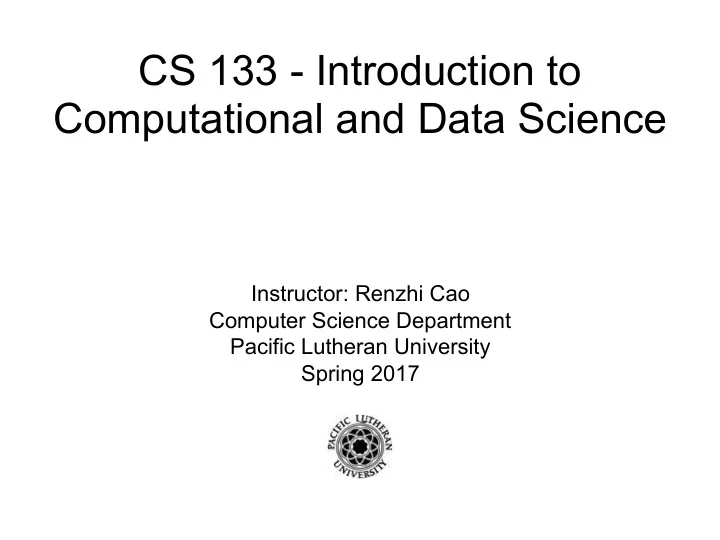

1 CS 133 - Introduction to Computational and Data Science Instructor: Renzhi Cao Computer Science Department Pacific Lutheran University Spring 2017
Probability • Quiz #3. • Check Sakai for exercises. • In the previous class, we learned Statistics • Today we are going to learn Probability
Probability Quantifying the uncertainty associated with events chosen from a universe of events. Universe: All possible outcomes Event: A subset of those outcomes Used to construct and evaluate models “The laws of probability, so true in general, so fallacious in particular” Edward Gibbon
Probability space Finite set of points, whereby each of them represents a possible outcome of a specific experiment • Each point (outcome) has a probability associated with it • Probabilities are always positive!!! • The sum of all probabilities is always 1 • Assume an equal probability distribution if not otherwise stated • e.g. 1/6 for a specific number of a die throw (unless die is not fair)
Probability space example 1 2 3 · 4 5 6 E · Event Event E that you roll a 2, 4, Probability space or 5 Imagine you throw a dart randomly at the box. You will hit the area of E 50% of the time. P(E) = 0.5
Example: Craps Throw 2 dice and calculate the probability of obtaining a total of 7 or 11. 36 possible outcomes The event contains 8 points. p = 8/36 ≈ 22% 6
Dependence and Independence The probability of an event E: P(E) What about two events? Events P and E are dependent if knowing something about whether E happens gives information about whether F happens. Independent: The opposite Tossing a coin two times: Dependent or independent? 7
Example 1: Conditional Probability Toss of 2 dice Probability space has 36 elements with equal probability 1/36 E: First comes out 1 (E 1 ) F: Second comes out 1 (E 2 ) = 6/36 = 1/6 P(E) = ? = 6/36 = 1/6 P(F) = ? = 1/6 P(F|E) = ? The experiments are independent , since P(F) = P(F|E) . It does not matter if E occurred or not; the probability of F stays the 8 same.
Independent Events Independent Events: P(E,F) = P(E)P(F) Example: Probability of getting two tails when flipping a coin two times. (Event E: first time gets tail. Event F: second time gets tail). How to calculate P(E) and P(F)? What is P(E,F)? P(E,F) = ½ * ½ = ¼ Probability of getting a tail and a head: 9
Example 2: Conditional Probability [1] Deal of 2 cards from a 52 card deck Number of points in experiment (probability space): Π (52,2) = 52 × 51 = 2,652 E: First card is an ace: 4 × 51 = 204 (4 choices for ace, 51 choices for second card) P(E) = 204/2,652 = 1/13 F: Second card is an ace: 4 × 51 = 204 (4 choices for ace, 51 choices for first card) P(F) = 204/2,652 = 1/13 P(F|E) = 12/204 = 1/17 (= 3/51) since there are 4 × 3 = 12 combinations for aces. 10
Example 2: Conditional Probability [1] Probability Space: 52 × 51 = 2,652 P(E) = 204/2,652 none of the cards is an ace E: first card is an ace P(F) = 204/2,652 4 × 51 = 204 P(F|E) = 12/204 2 aces 4 × 3= 12 4 × 51 = 204 F: second card is an ace The experiments are not independent , since P(F) ≠ P(F|E) . It does matter if E occurred or not; the probability of F changes. 11
Dependent Events Dependent Events: P(E|F) = P(E,F)/P(F), in which P(E|F)!=P(E) Examples: There are 5 marbles in a bag. 3 green and 2 red. P(1 st green) = ? 3/5 P(1 st and 2 nd green)= 9/25???? Nope! They are dependent events P(1 st and 2 nd green) = P(1 st ) * P(2 nd green | 1 st green) 3/5 * 2/4 = 3/10 12
One final example There are 300 students in the CS department. Of these students 90 play soccer, 30 play basketball, and 10 play both soccer and basketball. Let A be the event that a randomly selected student plays soccer and B be the event that the student plays basketball. What is P(A)? What is P(B)? What is P(A and B)? What is P(A|B)? 13
Project 2 CORGIS dataset: The C ollection of R eally G reat, I nteresting, S ituated Datasets https://think.cs.vt.edu/corgis/python/index.html
Recommend
More recommend